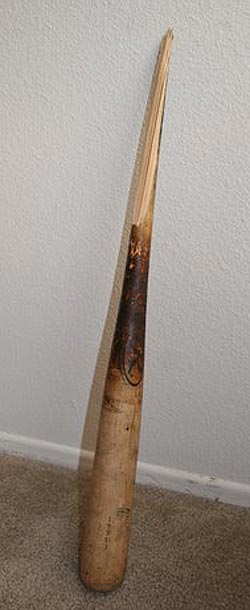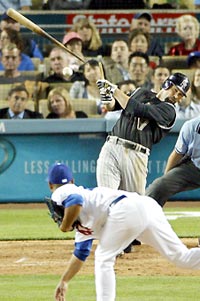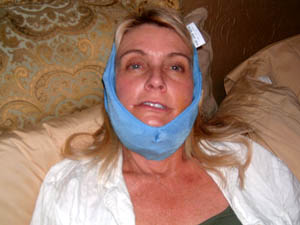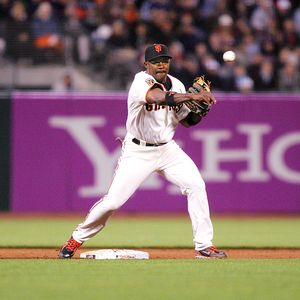
The bat swung by Todd Helton at Dodger Stadium that exploded and hit Susan Rhodes.
(Image courtesy Susan Rhodes)
The wire came out of Susan Rhodes’ mouth this week. Doctors replaced it with rubber bands, so now people can understand her when she tells the story of how a maple baseball bat shattered her jaw.
“Your whole life changes,” Rhodes says over the phone, and she’s not looking for sympathy. Just an explanation as to how Major League Baseball continues to allow maple bats when their danger becomes more obvious by the injurious incident.

The Rockies’ Todd Helton breaks his bat on a base hit off Dodgers reliever Cory Wade on April 25 at Dodger Stadium.
(AP Photo/Mark J. Terrill)
First came Pittsburgh Pirates hitting coach Don Long getting sliced along the cheek with the splintered end of a bat that snapped at the handle. Ten days later, on April 25, sitting four rows behind the visitor’s dugout at Dodger Stadium where Long was hit, Rhodes took the barrel end of a flying bat to the left side of her jaw.
What’s next? A fan or player dying?
At the recent owners’ meetings, commissioner Bud Selig highlighted maple bats as one of the game’s most pressing issues. A decade ago, they were barely in baseball. Since Barry Bonds’ record-breaking season, though, more than 50 percent of players have gone from the traditional ash bats to maple, which the converts claim feel harder.
A study commissioned by the league and the players’ union in 2005 showed maple and ash hit the ball equally well. Ash bats tend to crack innocuously, the study found, while maple bats explode, sending huge chunks of wood in every direction. When Todd Helton swung at a 2-1 pitch from Cory Wade in the seventh inning of the Colorado-Los Angeles game Rhodes attended, little did she know the remnants of the bat would reach all the way to her seats.
Rhodes, 50, wasn’t much of a baseball fan. Her friend John Andrews invited her and another friend, Gale Banks, to the game. Rhodes is a single mother of two teenaged boys, works in marketing and lives in the Los Angeles suburb of Sherman Oaks. It would be a nice time out, she figured.
And it was until Helton’s swing. He was borrowing a bat of teammate Troy Tulowitzki. While a Rockies spokesman said Tulowitzki uses both maple and ash, a clubhouse attendant speculated that because of the manner in which the bat snapped, it was almost in all likelihood maple. And a Rawlings spokesman said the last batch of bats made for Tulowitzki was maple.

Susan Rhodes with her son Remy, who was on the way to his prom. before the Dodgers game on April 25.
(Image courtesy Susan Rhodes)
The bat blew up, and Rhodes’ eyes followed the ball, which landed in center field for a single. Meanwhile, the bat tomahawked toward her.
When Rhodes recovered consciousness, she kept asking Banks what had happened, the concussion robbing her short-term memory.
“All I remember is feeling this complete slam against my face and pain,” Rhodes says. “You know when you’re in such shock, you think, ‘What the hell happened?’ I figured I got hit by a ball. I was very conscious of one flying and thought we aren’t in a very safe area. I don’t know if I was looking at the ball. I can’t remember anything except for the smash and total memory loss.”
Dodgers officials summoned paramedics who took Rhodes to an on-site triage center. Once stabilized, she was offered a ride to a nearby emergency room. Instead, she sought care closer to home, where a CAT scan revealed two jaw fractures, one on the upper-left side, where the bat struck, and the other on the lower right, where the force reverberated.
Once the swelling subsided three days later, Rhodes underwent surgery in which doctors inserted four screws and a titanium plate on the right side. For three weeks, Rhodes barely slept. Once, when her nose was clogged, Rhodes says she started panicking that she couldn’t breathe. Banks brought Rhodes nasal spray for the stuffiness and a Vicodin for the pain.
Since then, it hasn’t improved much. Rhodes subsists on liquid supplements Ensure and Boost and tries to come up with palatable concoctions in the blender. Migraines dig into her skull. Doctors can’t say for certain if she will recover fully.

Susan Rhodes recuperating after surgery on her jaw.
(Image courtesy Susan Rhodes)
“I had perfect teeth before,” Rhodes says. “They’ve shifted. My bite is off. The jaw on the left side has atrophied. I don’t have the same energy. I’ve got two kids, and I’m a single mother.
“It’s not easy. You just want to sleep. I don’t go out anymore. I’m exhausted.”
The medical bills have started to come in, and so far, Rhodes says, they’re more than $7,000. She’s not sure how much insurance will cover, so she contacted an attorney, Alan Ghaleb, to inquire about whether the Dodgers would help cover the costs. Ghaleb phoned the team and received a call back from American Specialty Insurance and Risk Services, an Indiana company that offers insurance to professional sports teams. The response shocked him.
“No way, no how, no way would they cover it,” Ghaleb says. “The adjuster was professional, but they would never consider helping anybody with their medical bills. It’s tough luck and you assume the risk.”
There is a reason every team announces before the game that teams are not responsible for flying bats and balls. The same is printed on tickets. Around Dodger Stadium, signs are posted: “Please be alert to bats and balls entering the seating area.” There’s a Spanish translation, too.
Fans who have brought litigation against baseball clubs for injuries due to batted balls and other projectiles have almost universally seen their cases dropped due to the assumption-of-risk doctrine. Every team that sees an injury at its stadium, no matter how serious, fights helping with medical costs because of the implications throughout the rest of the industry.
Ghaleb says that Rhodes is “considering (lawsuits) both against the Dodgers and the manufacturer.” He plans on deciding within 45 days whether cases are worth pursuing, and if he determines they aren’t, he will start a letter-writing campaign to Rawlings and the Dodgers on the dangers of maple bats.
“This is an unfortunate incident, and we wish her a speedy and full recovery,” Dodgers spokesman Josh Rawitch says.
Rhodes worries that the warnings aren’t enough. The issue of maple bats is so new, only the most ardent fans have heard of the danger. She figured a line drive into foul territory was enough of a threat. Now, having researched the Long incident and seen two or three or sometimes more bats per game breaking, Rhodes wonders why the netting that protects fans behind home plate isn’t lengthened to cover the baselines.
“Some child or someone’s parent is going to get killed,” Rhodes says. “I’m very fortunate this is all that happened. If it was just a few inches higher, it would’ve hit my temple or poked my eye out.
“Why wouldn’t they extend (netting)? I don’t get that. Would you like to live or would you like to see the game? If anything comes out of this, I want people to be safe.”
MLB and the union, though derelict in reaching an agreement to this point, want that as well. They will meet in June and go through a number of possible solutions, including netting, thickening the handles on bats so they’re less likely to snap or banning maple bats outright.
“We’re very concerned about this issue,” MLB spokesman Rich Levin says. “We are definitely looking into it. I know the commissioner is very concerned.”
As much as Rhodes appreciates the concern, it can’t return her life before a two-pound wooden club blindsided her. She wonders how a sport can put its players and fans in such precarious positions, prone to assaults with a deadly weapon.
Rhodes won’t find out again anytime soon.
“From now on,” she says, “I’m going to Lakers games.”
Original here
 Well, ultimate fighting is now officially an acceptable sport for mainstream America. Tomorrow night, CBS is showing a live fight featuring none other than the Miami headcracker, Kimbo Slice. He's an ex-bouncer who's risen to fame, fortune, and respectability solely through brutal, bare-knuckle fight videos of him on YouTube. A true American success story for our modern age. Half of you are saying, "Who?" The other half are saying, "My favorite was when that guy in the backyard kept trying to pause the fight, but Kimbo knocked the hell out of him anyways." Though there will be some halfhearted controversy over CBS' decision, we're calling it right now: ultimate fighting is no longer a trend, or an oddity; it's a part of the sporting establishment that families can watch together. Two of Kimbo's YouTube classics are after the jump. America will have its blood:
Well, ultimate fighting is now officially an acceptable sport for mainstream America. Tomorrow night, CBS is showing a live fight featuring none other than the Miami headcracker, Kimbo Slice. He's an ex-bouncer who's risen to fame, fortune, and respectability solely through brutal, bare-knuckle fight videos of him on YouTube. A true American success story for our modern age. Half of you are saying, "Who?" The other half are saying, "My favorite was when that guy in the backyard kept trying to pause the fight, but Kimbo knocked the hell out of him anyways." Though there will be some halfhearted controversy over CBS' decision, we're calling it right now: ultimate fighting is no longer a trend, or an oddity; it's a part of the sporting establishment that families can watch together. Two of Kimbo's YouTube classics are after the jump. America will have its blood:

 The bat swung by Todd Helton at Dodger Stadium that exploded and hit Susan Rhodes.
The bat swung by Todd Helton at Dodger Stadium that exploded and hit Susan Rhodes.  The Rockies’ Todd Helton breaks his bat on a base hit off Dodgers reliever Cory Wade on April 25 at Dodger Stadium.
The Rockies’ Todd Helton breaks his bat on a base hit off Dodgers reliever Cory Wade on April 25 at Dodger Stadium.  Susan Rhodes with her son Remy, who was on the way to his prom. before the Dodgers game on April 25.
Susan Rhodes with her son Remy, who was on the way to his prom. before the Dodgers game on April 25.  Susan Rhodes recuperating after surgery on her jaw.
Susan Rhodes recuperating after surgery on her jaw.